| Home - Back Issues - The Team - Contact Us |
 |
| Volume 10 |Issue 27 | July 15, 2011 | |
|
|
Cover Story DU Turns 90 There are few universities in the world that have been able to transform the spirit of free thinking into an unstoppable cultural movement, assuming thereby the role of a guiding force for a people in times of acute national crisis. The University of Dhaka (DU) is one of those few that, besides sparking an inquisitive zeal among students, has intertwined its course with the emergence of a country and all her subsequent upheavals. It laid the foundation of Bengali nationalism in terms of common linguistic and cultural codes, which later paved the way for provincial autonomy leading to independence. It has, however, come a long way since its inception on July 1, 1921 with a considerable increase in students, new departments, faculties, and so on. But the glorious past of student politics has now fallen prey to a new brand of politics marked by the ominous clanking of deadly weapons and inevitable in-fighting over the business of tender. This alone blurs all its shining outlines, past and present. Besides a downslide of its performance in the world ranking of universities, the burgeoning crisis of dormitories has compounded students' sufferings. Be that as it may, on the occasion of its ninetieth founding anniversary, the biggest educational institute of the country deserves a look into its glorious past and adjusted present. A journey through its chequered history is somewhat indistinguishable from the history of Bangladesh itself. Rifat Munim
The one inconsistency that had thrown Buddhadev Bose off balance was the lifeless appearance of a handful of female students compounded with their stunning silence both inside and outside the class. They were always guarded by the teachers so that no male student could even talk to them. Professor Emeritus of DU Anisuzzaman, shares an all but similar experience with a slight change in context. He enrolled in the Department of Bengali at DU in 1953. After finishing PhD, he joined there as a lecturer in 1959. “There was no talking with the female students. If one wished to, he would have to apply to the Proctor explaining in detail why he needed to talk. In order to avoid these complexities, what some outrageous students would do was, instead of walking side by side, the boy would walk behind the girl and talk.”
“But such dogmatic practices were beginning to change during our time. The appearance of female actors on stage was strictly prohibited in those days. But we succeeded to bring female actors on stage for the first time in 1953 at the Salimullah Muslim Hall. However, the teachers just made sure that their guardians were okay with it. So there was restriction, but there was support too from the teachers' side.” There was only one cultural organisation named Sangskriti Sangsad which arranged literary and cultural programmes. But the centre of all cultural activities was based in the dormitories. A hall-based student's union, elected by the students of the hall, regularly organised debate, literary, cultural and sporting competitions. In the 50s, Anisuzzaman recollects, elections of central or hall-based unions were held regularly. “Because of hall-based cultural activities, bright students through their performance and organisational skills could easily draw attention and get elected in the next election,” he says. “More importantly, we tasted the collective hall life to the fullest, which naturally created a bond and a sense of solidarity amongst us,” he adds. In the 1960s and subsequent decades, more and more students enrolled and expanded the horizons of all sorts of activities. The culture of progressive politics in DU coincided with the partition of India. After the partition, when Urdu was declared the state language of Pakistan at the convocation of DU in March 1948, an organised language movement was initiated in and later directed through the DU campus. Abdul Matin, otherwise known as Bhasa Matin was the convenor of the DU State Language Movement Committee formed in 1950. He says, “National leaders such as Maulana Bhasani took to the streets supporting the cause of the language. However, it was the students who invigorated the movement. All students' activities were centred on DU campus, later it spread among mass people and students in other divisions and districts.”
The 1960s represented the golden era of students' organised movement against the oppressive regime that shook the base of the Pakistani rulers. Beginning with the education movement against the Hamoodur Rahman Commission report, the DU students buttressed by other institutions like Dhaka College contributed substantially to the historical six-point movement in 1966 and the mass uprising in 1969. Ruling Awami League MP Tofael Ahmed, who was the Dhaka University Central Students Union (DUCSU) VP from the Chhatra League in 1968-69, says:
Mujahidul Islam Selim, president of Communist Party of Bangladesh, was the first DUCSU VP from Chhatra Union in the independent Bangladesh in 1972-73. He says, “Now students say they are involved with students' politics clearly indicating that they have to operate under the dictates of national leaders. However, in our times, we used to say that we're involved with students' struggles and movements, and our works were not hampered by national leaders. And what were the struggles for? The struggles were first to stand against the discriminatory education policy and then to ensure everyone's access to a progressive education system.” Admitting to the combined effort of student's organisations in the 60s, he however says that Chhatra League and one of its factions deviated from the path of progressive politics after independence.
There were two students' bodies in DU during that time: one was Sangram Parishad led by Chhatra league, which included Chhatra Union, Jasod Chhatra League (JSD), Chhatra Moitri; and Sangrami Chhatra Jote led by Chhatra Dal, which included Ganotantrik Chhatra League and Biplobi Chhatra Moitri. “After Dr Milon and Mustafa Jamal Mohiuddin of DMC were shot dead by police on November 27, all the 22 students' organisations of DU came together and the movement culminated in Ershad's resignation in one week.”
“Without regular DUCSU elections, competent national leadership cannot be created,” says Tofael Ahmed. Mujahidul Islam Selim thinks that today's rotten campus-based politics of plundering is a result of market economy characterised by greed and profit. He says, “There is no alternative to transparent DUCSU elections if we want to restore the healthy, progressive trend of politics in DU and other public universities.” Aman says that for an election to be held, the authority first has to ensure the peaceful co-existence of different students' organisations. “Student leaders must develop tolerance and stay peacefully at the dormitories since it is everyone's right to express his political views.” The absence of an elected DUCSU has also led to dirty politicisation in the dormitories. Many non-residential students and outsiders under the aegis of powerful political leaders occupy seats while residential students are deprived, allege several students requesting anonymity. Worse, sometimes residential students, who have no political affiliation, are compelled to join a procession by student leaders. All the former DUCSU VPs believe that regular elections can put an end to all these undesirable practices and if the DU authorities are serious, they add, the culture of regular elections can be restored. The DU vice-chancellor AAMS Arefin Sidique admits to the utmost importance of DUCSU election and says that a change has begun in the political culture of DU. However, he stresses that without the students' good intentions, this culture cannot be restored (see box below).
Then there is the pivotal issue of quality education which perhaps accounts for DU's poor performance in the world ranking of universities. A growing lack of motivation is also evident in the students. Besides, politicisation in the teachers' recruiting process often employs unqualified students as teachers. Dr Md Yousuf Ali Molla, dean of the science faculty, says that a lack of motivation among students and poor performance of many teachers are responsible for the deterioration of quality education. “Yet, I believe that we still have the most brilliant teachers and students working and studying here. All we lack is proper opportunities, not talents. Moreover, political instability often hampers studies.”
“Whenever we talk about DU, we emphasise its political role and the glorious, political past but we never say that DU has made its mark internationally not for politics, but for its scientific researches. We have so many meritorious students who are now competing internationally. Because we cannot create opportunities for them, they are leaving this country and not coming back,” laments Dr Khan. The Vice Chancellor Arefin Siddique holds the inadequacy of the budget responsible for many of its problems. Still, he is optimistic about continuing the glorious legacy of DU. “The inadequate budget holds back infra-structural development and other progresses. Despite all limitations, I firmly believe that the devoted, meritorious students of DU will keep up its glorious legacy and uphold the country's image to the whole world,” he says.
Copyright
(R) thedailystar.net 2011 |
||||||

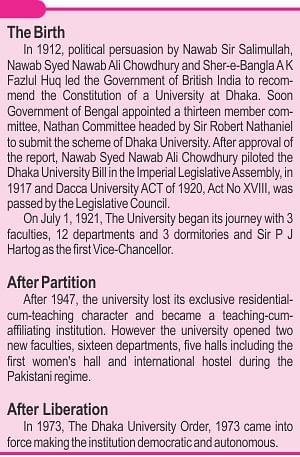 I
I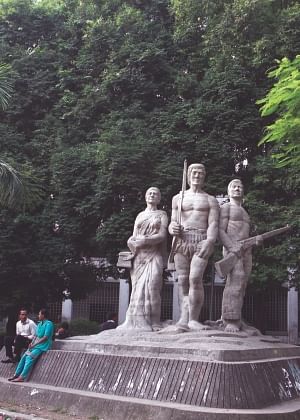 When there were cultural functions, the same conditions prevailed but with the permission of the Proctor female students could come and perform for a very limited time while being under constant surveillance. Permission was required even for arranging literary or cultural gatherings.
When there were cultural functions, the same conditions prevailed but with the permission of the Proctor female students could come and perform for a very limited time while being under constant surveillance. Permission was required even for arranging literary or cultural gatherings. 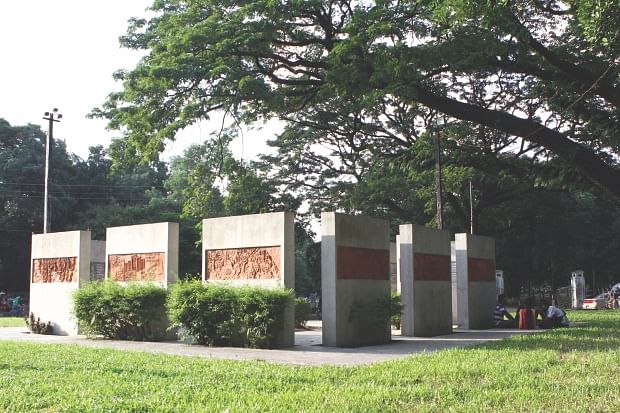
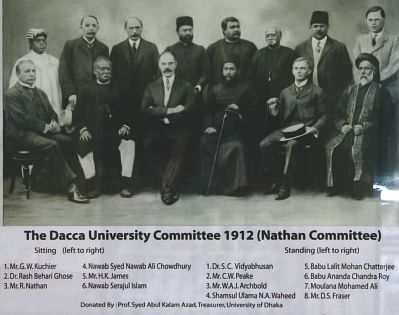 “It was solely for the indomitable spirits of the students that the anti-Ayub agitation could not be suppressed. I'm proud to say that the DU students led the student's front in those days. When the Agartala conspiracy trial of Sheikh Mujib began in June 1968, we formed All-Party Students' Association and freed him. When the Pakistani police gunned down Asad and Matiur in January 1969, all the students' organisations in a combined effort gave such a push that Ayub Khan had to step down,” he says, “The most intriguing thing was that despite ideological differences we the students could work together whenever the country needed us.” That was how Chhatra Union leaders Rashed Khan Menon and Matia Chowdhury; and Chhatra League leaders Tofael Ahmed, ASM Abdur Rab, Shahjahan Siraj and Nure Alam Siddiqui were brought together.
“It was solely for the indomitable spirits of the students that the anti-Ayub agitation could not be suppressed. I'm proud to say that the DU students led the student's front in those days. When the Agartala conspiracy trial of Sheikh Mujib began in June 1968, we formed All-Party Students' Association and freed him. When the Pakistani police gunned down Asad and Matiur in January 1969, all the students' organisations in a combined effort gave such a push that Ayub Khan had to step down,” he says, “The most intriguing thing was that despite ideological differences we the students could work together whenever the country needed us.” That was how Chhatra Union leaders Rashed Khan Menon and Matia Chowdhury; and Chhatra League leaders Tofael Ahmed, ASM Abdur Rab, Shahjahan Siraj and Nure Alam Siddiqui were brought together.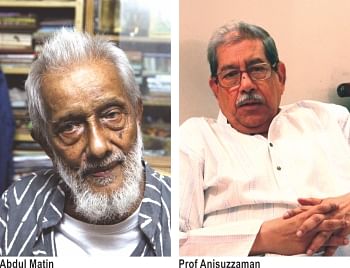 “Despite some deviations, the progressive front overpowered students' movements till 1975,” opines Selim. After 1975, the country fell under the clutches of a series of autocratic rulers creating emptiness in the country's political sphere. However, it did not take the DU students long to come under the same roof and start agitation. Amanullah Aman, BNP joint secretary general, was the last DUCSU VP and was at the forefront of the anti-Ershad movement throughout the 80s. He says, “I think one reason why the DU-based anti-Ershad movement stands out is when the national leaders failed to unite, we the different students' organisations got united in 1990 and forced our national leaders to do the same. It was only then that the movement turned out successfully.”
“Despite some deviations, the progressive front overpowered students' movements till 1975,” opines Selim. After 1975, the country fell under the clutches of a series of autocratic rulers creating emptiness in the country's political sphere. However, it did not take the DU students long to come under the same roof and start agitation. Amanullah Aman, BNP joint secretary general, was the last DUCSU VP and was at the forefront of the anti-Ershad movement throughout the 80s. He says, “I think one reason why the DU-based anti-Ershad movement stands out is when the national leaders failed to unite, we the different students' organisations got united in 1990 and forced our national leaders to do the same. It was only then that the movement turned out successfully.”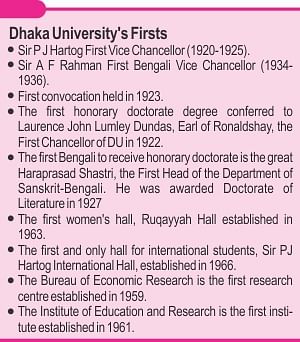 At the expense of so many fresh lives, democracy was restored in December 1990. However, what constitutes the most ironic episode of this restoration in DU is the fact that with the advent of democracy the DUCSU was literally made inactive. The DUCSU election has not been held since 1990. It is not only the students' rights, but also a prerequisite for ensuring a healthy cultural life for the students.
At the expense of so many fresh lives, democracy was restored in December 1990. However, what constitutes the most ironic episode of this restoration in DU is the fact that with the advent of democracy the DUCSU was literally made inactive. The DUCSU election has not been held since 1990. It is not only the students' rights, but also a prerequisite for ensuring a healthy cultural life for the students. 
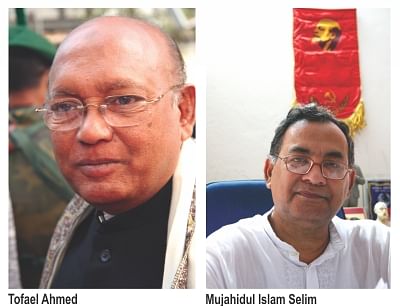 The university in its long itinerary has grown to be the biggest educational institution of the country. However, its residential facilities have not grown in proportion to its increasing number of students. According to a rough estimate of the registrar office, in the 2009-10 sessions, there were 19,200 male students with 14 dormitories and 10, 373 female students with only four dormitories. While more than half of the male students remain outside the residential facilities, the female students go through the worst ordeal with less than one third of them enjoying the facility. Even so, the lucky ones for the first two or three years have to share a tiny single bed with another student until she is in the fourth year. On an average, a four-seat room of Rokeya Hall has at least seven students often causing severe mental crises to the younger students, allege a Rokeya Hall student on condition of anonymity. However, sources from the registrar office say that many problems are created because of session jam.
The university in its long itinerary has grown to be the biggest educational institution of the country. However, its residential facilities have not grown in proportion to its increasing number of students. According to a rough estimate of the registrar office, in the 2009-10 sessions, there were 19,200 male students with 14 dormitories and 10, 373 female students with only four dormitories. While more than half of the male students remain outside the residential facilities, the female students go through the worst ordeal with less than one third of them enjoying the facility. Even so, the lucky ones for the first two or three years have to share a tiny single bed with another student until she is in the fourth year. On an average, a four-seat room of Rokeya Hall has at least seven students often causing severe mental crises to the younger students, allege a Rokeya Hall student on condition of anonymity. However, sources from the registrar office say that many problems are created because of session jam. “Students are coming in every year and getting seats while old students of outgoing batches are not leaving because their courses are not completed for session jam. Besides, some politically affiliated and dishonest students also create problems by occupying seats illegally,” says an official of the Registrar office anonymously.
“Students are coming in every year and getting seats while old students of outgoing batches are not leaving because their courses are not completed for session jam. Besides, some politically affiliated and dishonest students also create problems by occupying seats illegally,” says an official of the Registrar office anonymously. A dearth of quality research lies behind all these because good research not only boosts performance in world rankings, but also facilitates quality education. Dr Haseena Khan of Biochemistry and Molecular Biology, who headed one of the units in the research led by Dr Maqsudul Alam that discovered the genetic code of the jute genome, says that the importance of research is always undermined in our country.
A dearth of quality research lies behind all these because good research not only boosts performance in world rankings, but also facilitates quality education. Dr Haseena Khan of Biochemistry and Molecular Biology, who headed one of the units in the research led by Dr Maqsudul Alam that discovered the genetic code of the jute genome, says that the importance of research is always undermined in our country.

